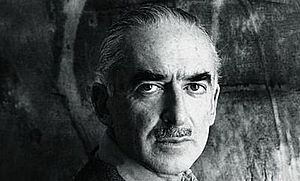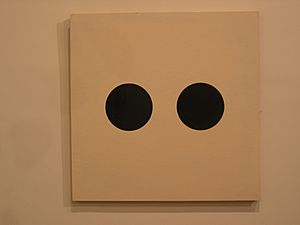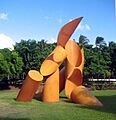Alexander Liberman facts for kids
Quick facts for kids
Alexander Liberman
|
|
|---|---|
 |
|
| Born |
Alexander Semeonovitch Liberman
September 4, 1912 Kyiv, Ukraine, then in Russian Empire
|
| Died | November 19, 1999 (aged 87) Miami, Florida, US
|
| Nationality | Russian, American (after 1946) |
| Education | University School, Hastings, Sussex, England, 1921–22 St. Pirans School, Maidenhead, Berkshire, England, 1923–24 Ecole des Roches, 1924–1927 Sorbonne, 1927–1930, philosophy and mathematics, studied painting, under André Lhote, Paris, 1931 Ecole Speciale d'Architecture, Paris, 1931–32 (under Auguste Perret) École des Beaux-Arts in Paris, 1932–33 |
| Occupation | magazine editor, publisher painter, photographer, sculptor |
| Employer | Vogue magazine (1943–) Condé Nast Publications (1960–1994) |
| Title | Editorial Director |
| Spouse(s) | Hildegarde Sturm (1936–??) Tatiana Yacovleff du Plessix (1942–1991) Melinda Pechangco (1992–1999) |
| Children | Francine du Plessix Gray stepdaughter, not adopted |



Alexander Semeonovitch Liberman (born September 4, 1912 – died November 19, 1999) was a talented Ukrainian-American artist and editor. He was known for his work as a magazine editor and publisher, but also as a painter, photographer, and sculptor. He held important artistic jobs at Condé Nast Publications for 32 years.
Contents
Life and Early Career
Alexander Liberman was born into a Jewish family in Kyiv, Ukraine. When his father became an advisor to the Soviet government, his family moved to Moscow. Life became difficult there. In 1921, his father received special permission from Lenin to take Alexander to London.
Young Alexander studied in Ukraine, England, and France. He lived in Paris as a "White émigré", which means he was a Russian who left his home country after the Russian Revolution.
He started his career in publishing in Paris from 1933 to 1936. He worked for an early picture magazine called Vu. There, he was an art director and then a managing editor. He worked with famous photographers like Brassaï and Robert Capa.
In 1941, he moved to New York. He began working for Condé Nast Publications, a big publishing company. He rose through the ranks to become the editorial director, a position he held from 1962 to 1994.
Artistic Journey
Liberman started painting in the 1950s. Later, he began creating sculptures out of metal. His sculptures are easy to recognize. He made them from industrial objects like steel beams, pipes, and drums. He often painted them in bright, solid colors.
In an interview in 1986, Liberman said that many artworks are like "screams," and he felt a connection to that idea. One of his huge works is called The Way. It is made from eighteen old steel oil tanks. This sculpture became a famous piece at Laumeier Sculpture Park in St. Louis, Missouri.
Before he became well-known for painting and sculpture, Liberman was a photographer. Starting in 1948, he spent his summers visiting and photographing many modern European artists in their studios. These artists included Henri Matisse, Pablo Picasso, and Constantin Brancusi.
In 1959, the Museum of Modern Art in New York City showed Liberman's photographs of artists and their studios. The next year, these photos were put into his first book, The Artist in his Studio.
Personal Life
Alexander Liberman was married three times. He was briefly married to Hildegarde Sturm in 1936. In 1942, he married Tatiana Yacovleff du Plessix. She was a model and designed hats. They moved to New York together in 1941. Tatiana worked as a hat designer for stores like Henri Bendel and Saks Fifth Avenue. After Tatiana passed away, he married Melinda Pechangco in 1992. His stepdaughter, Francine du Plessix Gray, became a well-known author.
Career Highlights
Liberman's career began in 1930 as a part-time design assistant for graphic artist A. M. Cassandre in Paris. He became a full-time painter in 1936. He served in the French army in the 1940s.
He started taking photographs in 1949 and sculpting in 1958. Liberman worked for Vogue magazine for 58 years, starting in 1941. He was hired by Condé Nast as an assistant art director for Vogue. A year later, he became the magazine's art editor.
From 1944 to 1961, as Vogue's art director, he published Lee Miller's photographs. In 1962, he was promoted to editorial director for all Condé Nast publications in the United States and Europe. He held this role until 1994. Throughout his life, Liberman had many exhibitions of his paintings and sculptures.
Awards and Recognition
Alexander Liberman received several awards for his work:
- Gold Medal for Design, Exposition Internationale, Paris, 1937
- Doctor of Fine Arts from Rhode Island School of Design, Providence, 1980
Notable Artworks
Here are some of Alexander Liberman's well-known sculptures:
- Prometheus (1964), Minneapolis, Minnesota
- Ritual II (1966), Milwaukee, Wisconsin
- Orbits (1967), Milwaukee, Wisconsin
- Axeltree (1967), Milwaukee, Wisconsin
- Temple II (1964-1969), Albany, New York
- Contact II (1972), Portland, Oregon
- Gate of Hope (1972), University of Hawaii at Manoa
- Above, Above (1972), Saint Paul, Minnesota
- Path (1973), Granville, Ohio
- Argo (1974), Milwaukee, Wisconsin
- Phoenix (1974), Los Angeles County Museum of Art, Los Angeles, California
- Covenant (1975), University of Pennsylvania, Philadelphia, Pennsylvania
- Symbol (1978), Rockford, Illinois
- On High (1979), New Haven, Connecticut
- Stargazer (1983), San Diego, California
- Olympic Iliad (1984), Seattle, Washington
- Faith (1984), Jerusalem, Israel
- Galaxy (1985), Oklahoma City, Oklahoma
- Trope I (1986), Norfolk, Virginia
- Abracadabra (1992), Hamilton, Ohio
- Archway (1997), Wonju, South Korea
- The Way (1980), Laumeier Sculpture Park, Greater St. Louis, Missouri
- Thrust (1980), Stamford, Connecticut
Art Collections
Liberman's art can be found in many important collections, including:
- Metropolitan Museum of Art
- Storm King Art Center
- Hirshhorn Museum and Sculpture Garden
- Pyramid Hill Sculpture Park and Museum
- Tate Gallery
- Guggenheim Museum
See Also
 In Spanish: Alexander Liberman para niños
In Spanish: Alexander Liberman para niños
Images for kids
-
Alexander Liberman, Gate of Hope, painted steel, 1972, University of Hawaii at Manoa
-
Liberman's Two Circles (1950) in the Metropolitan Museum of Art
-
Liberman's Faith (1984) in Jerusalem





